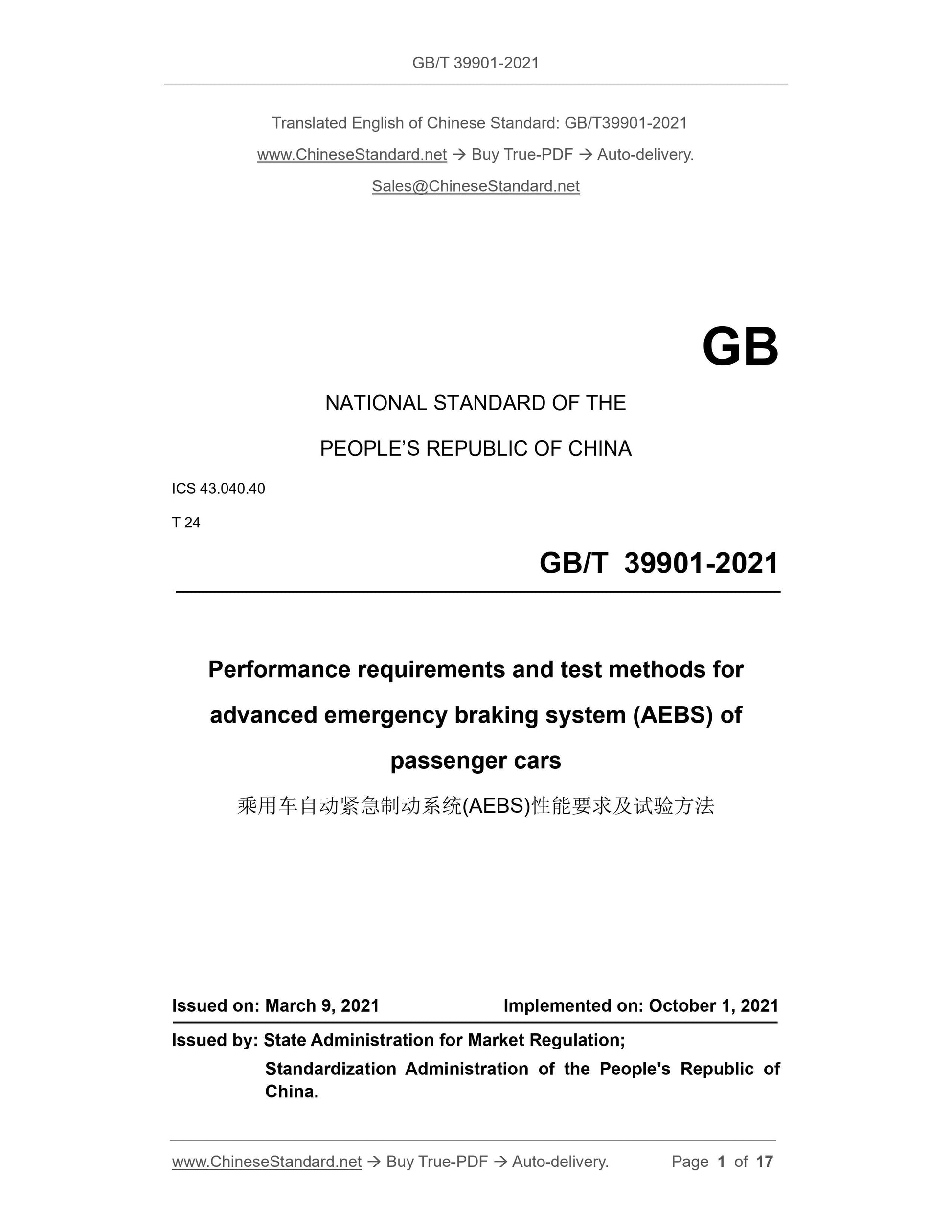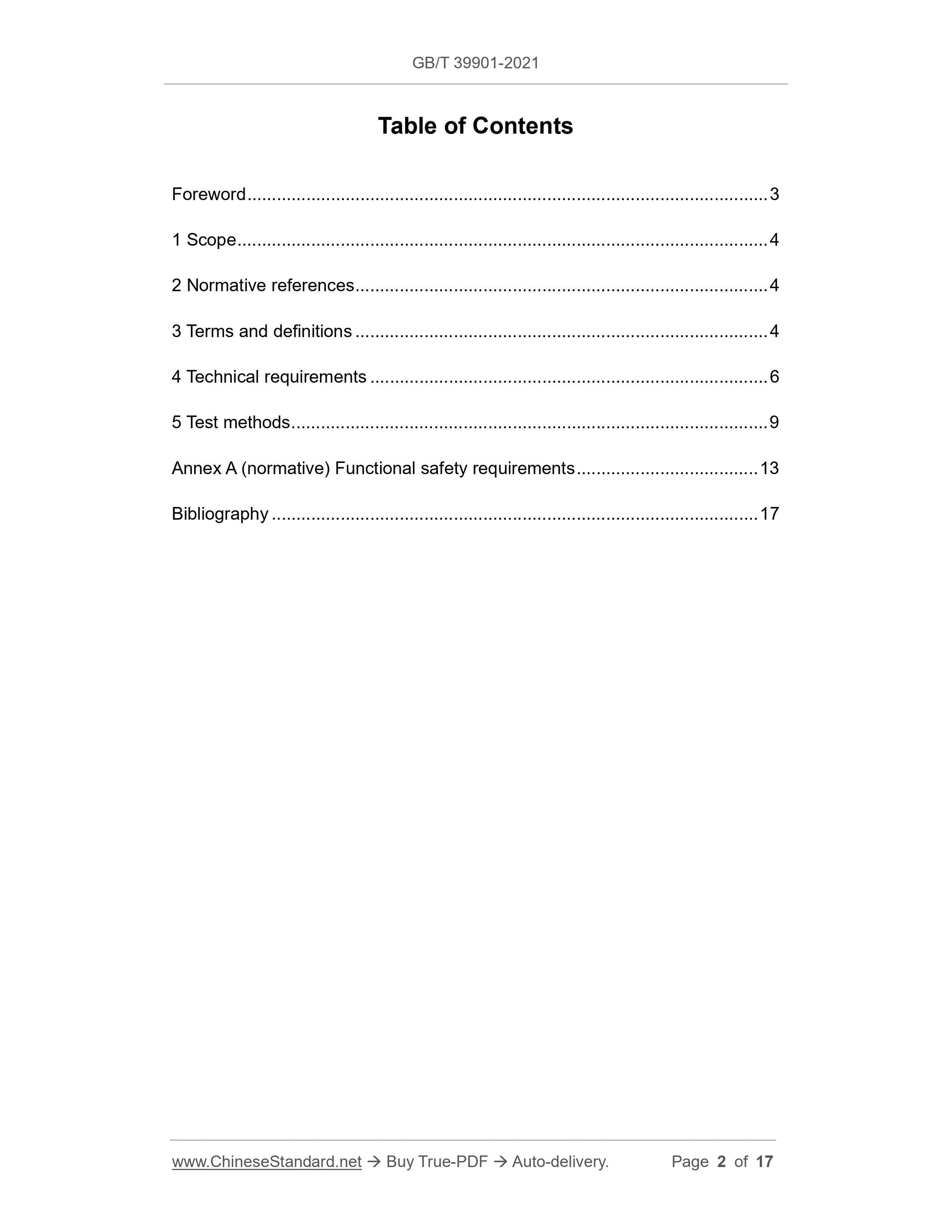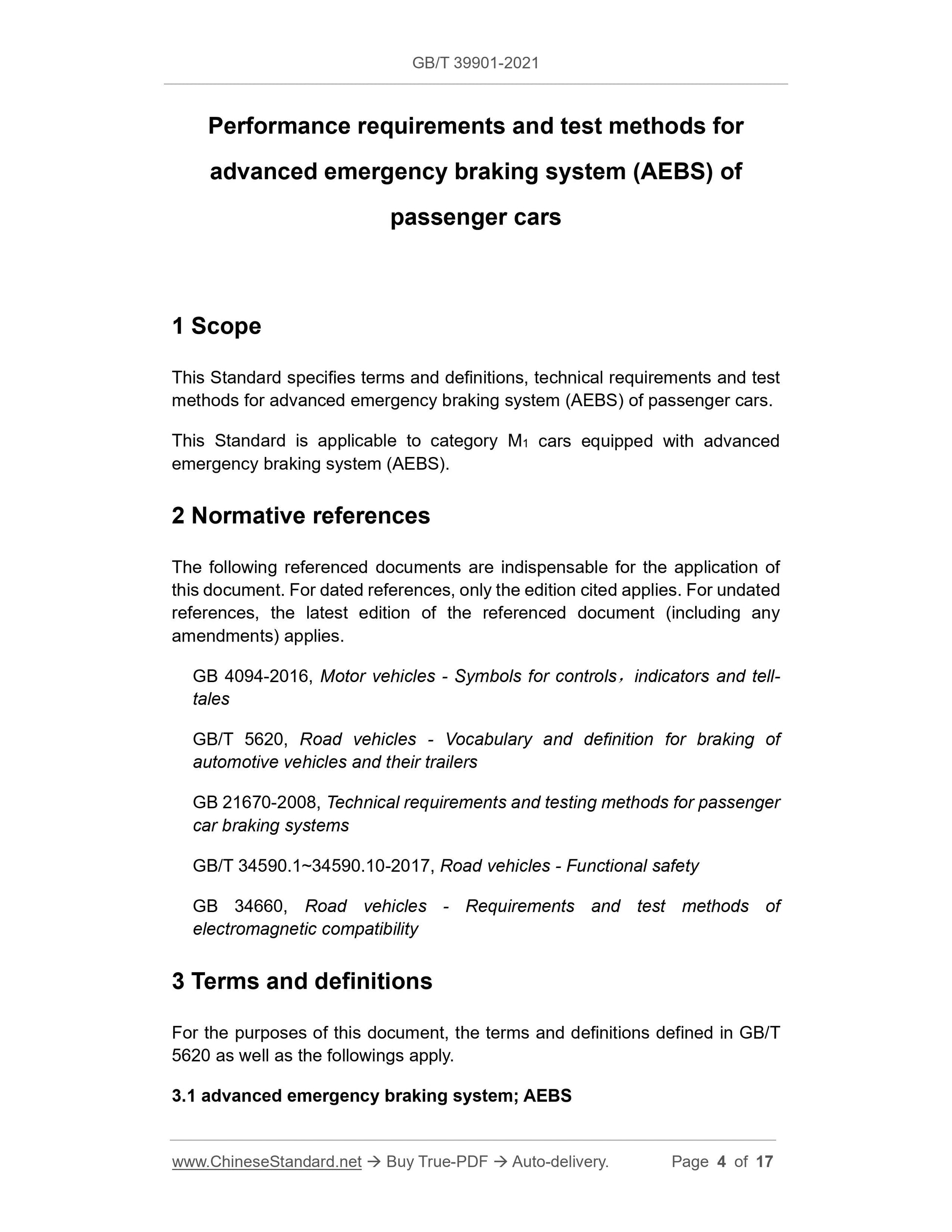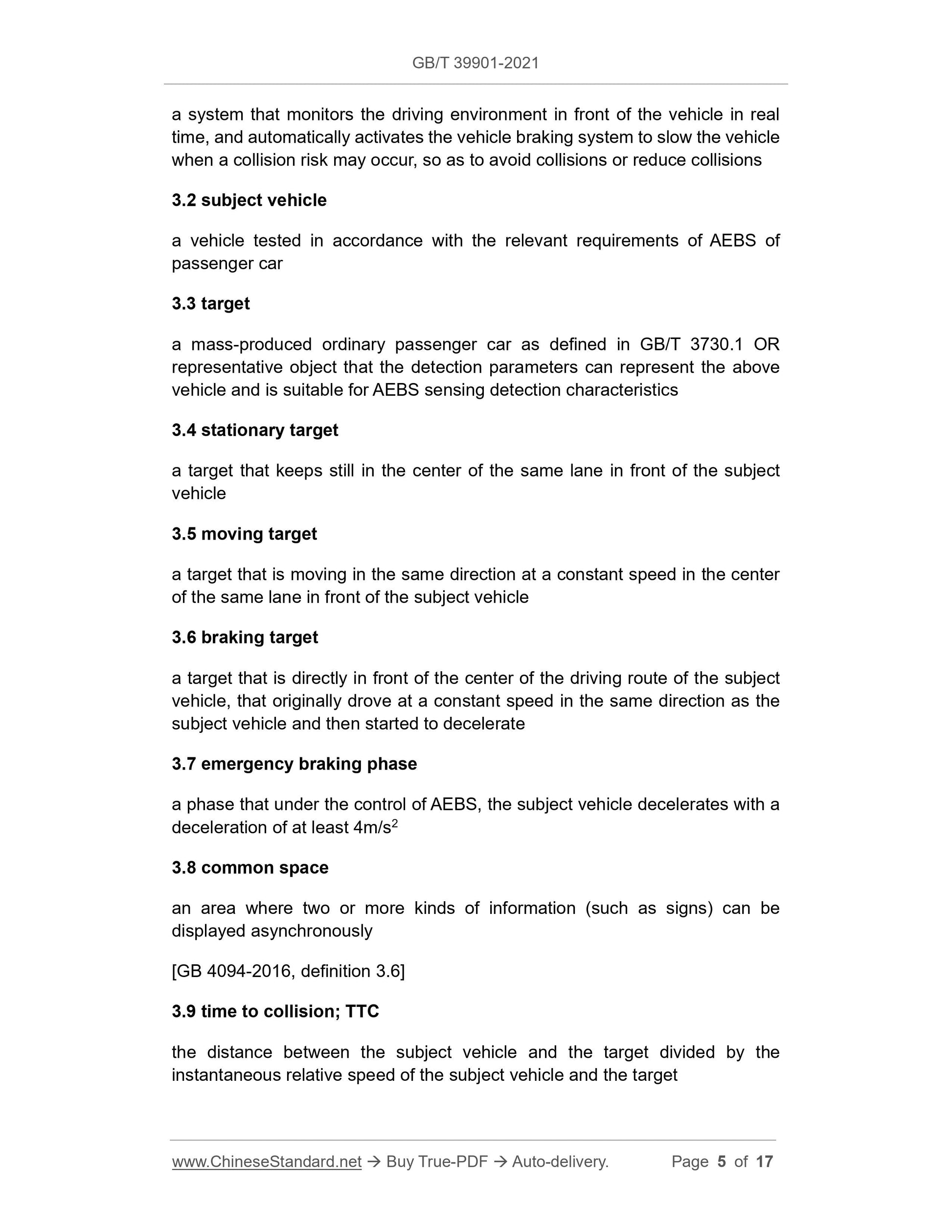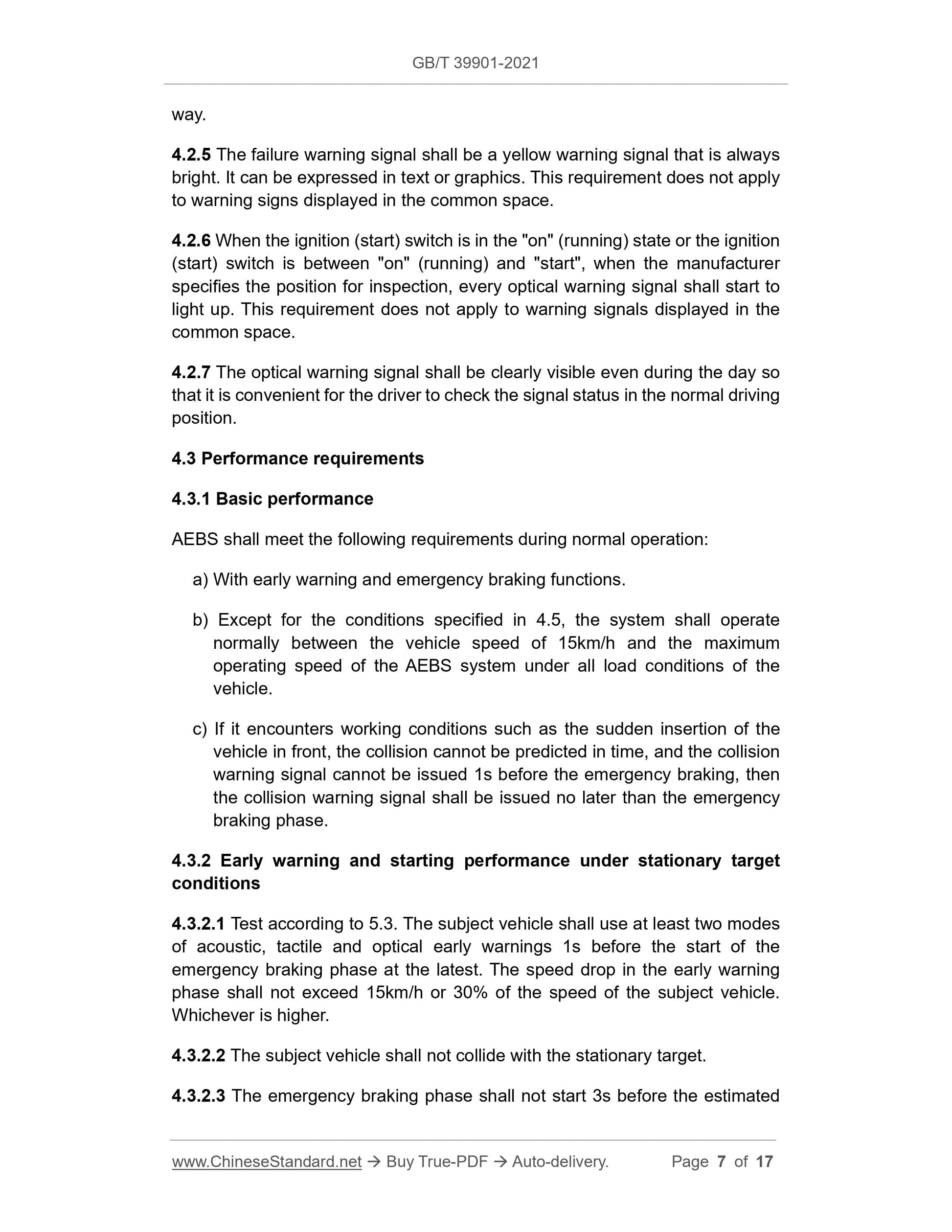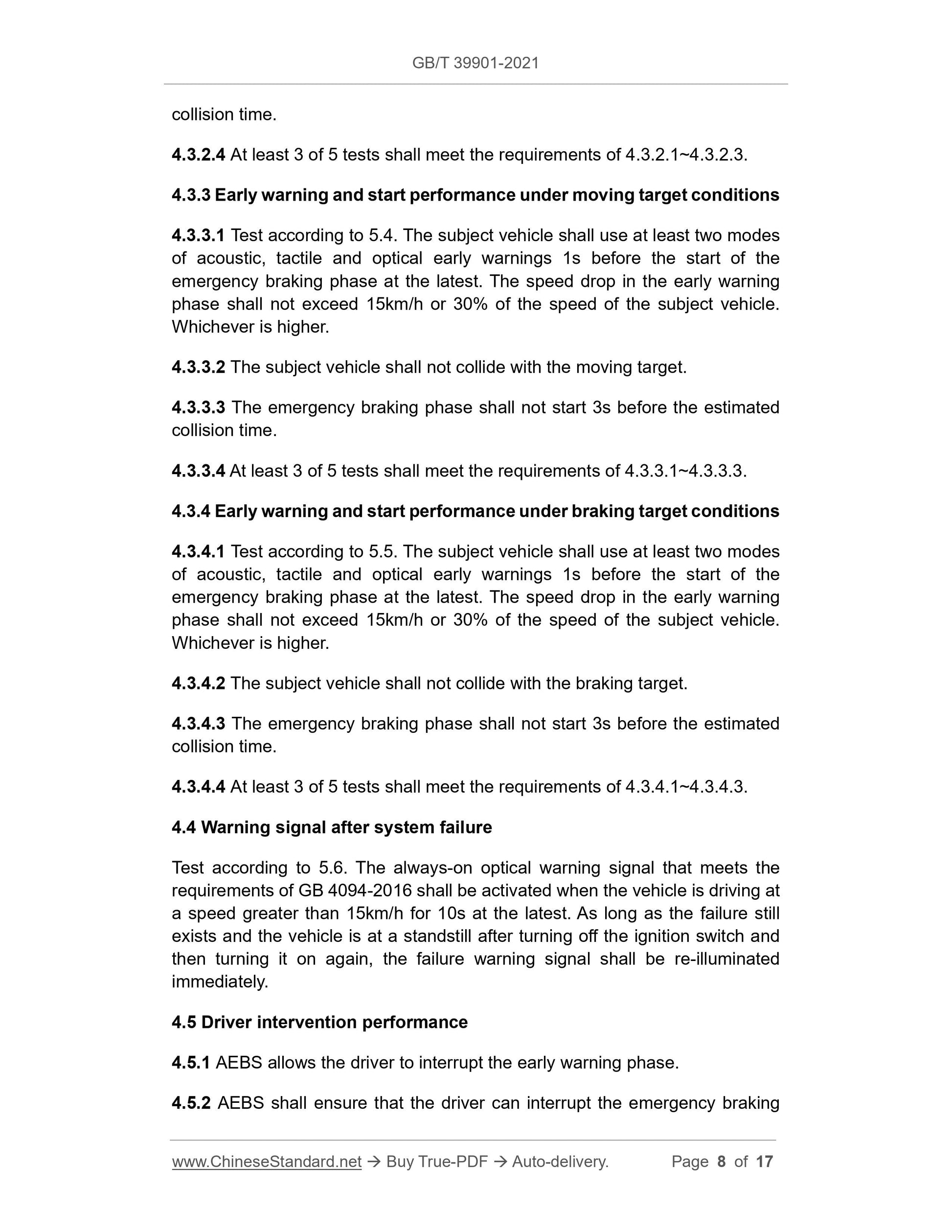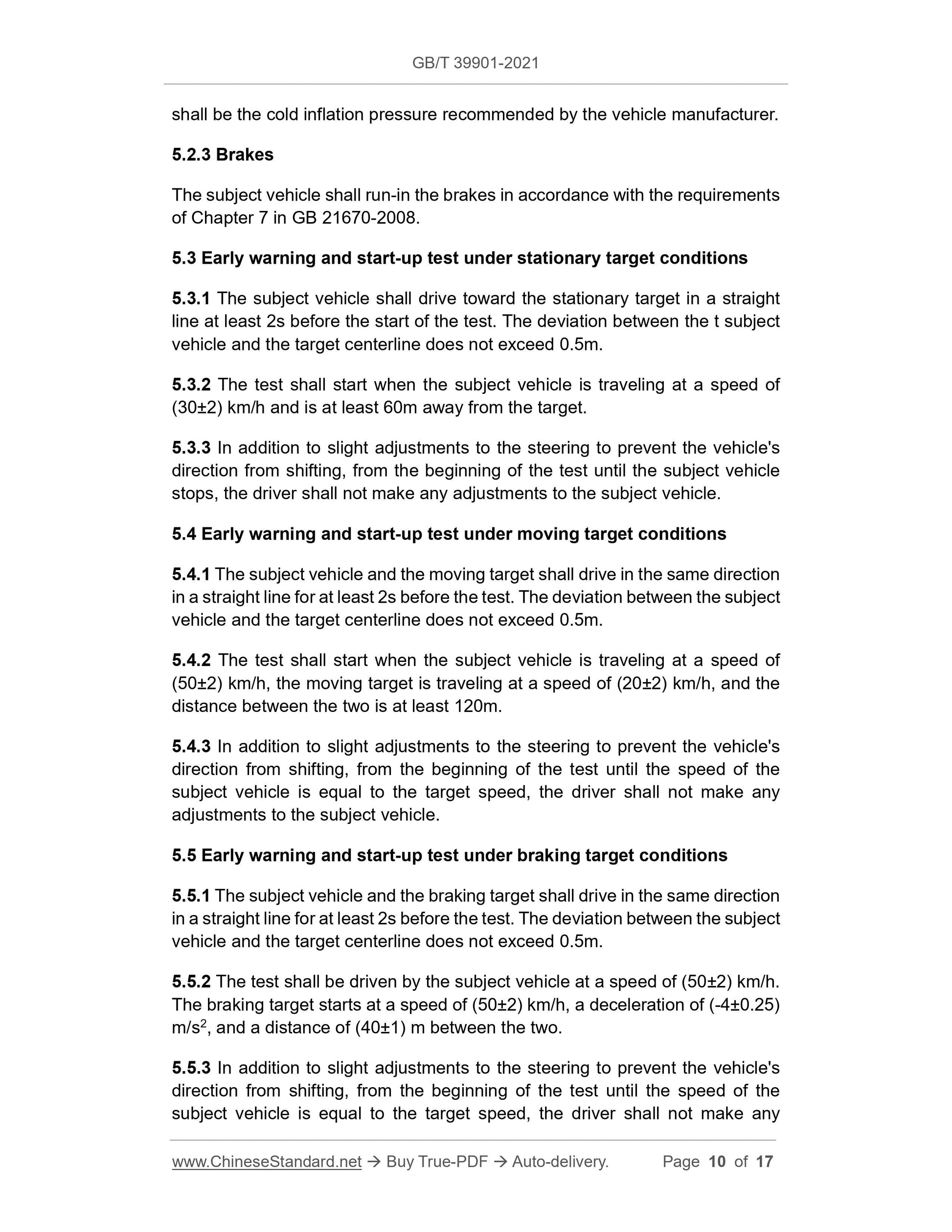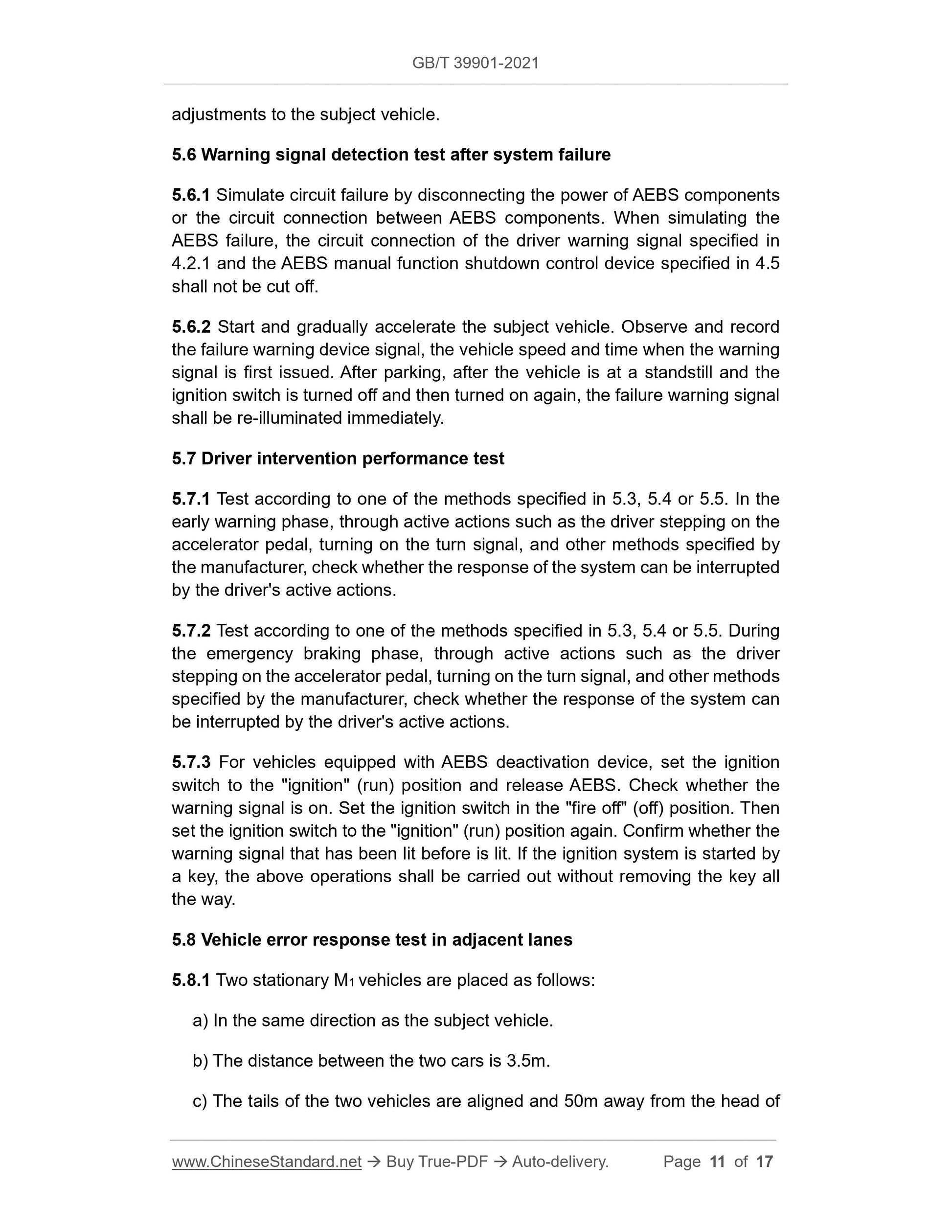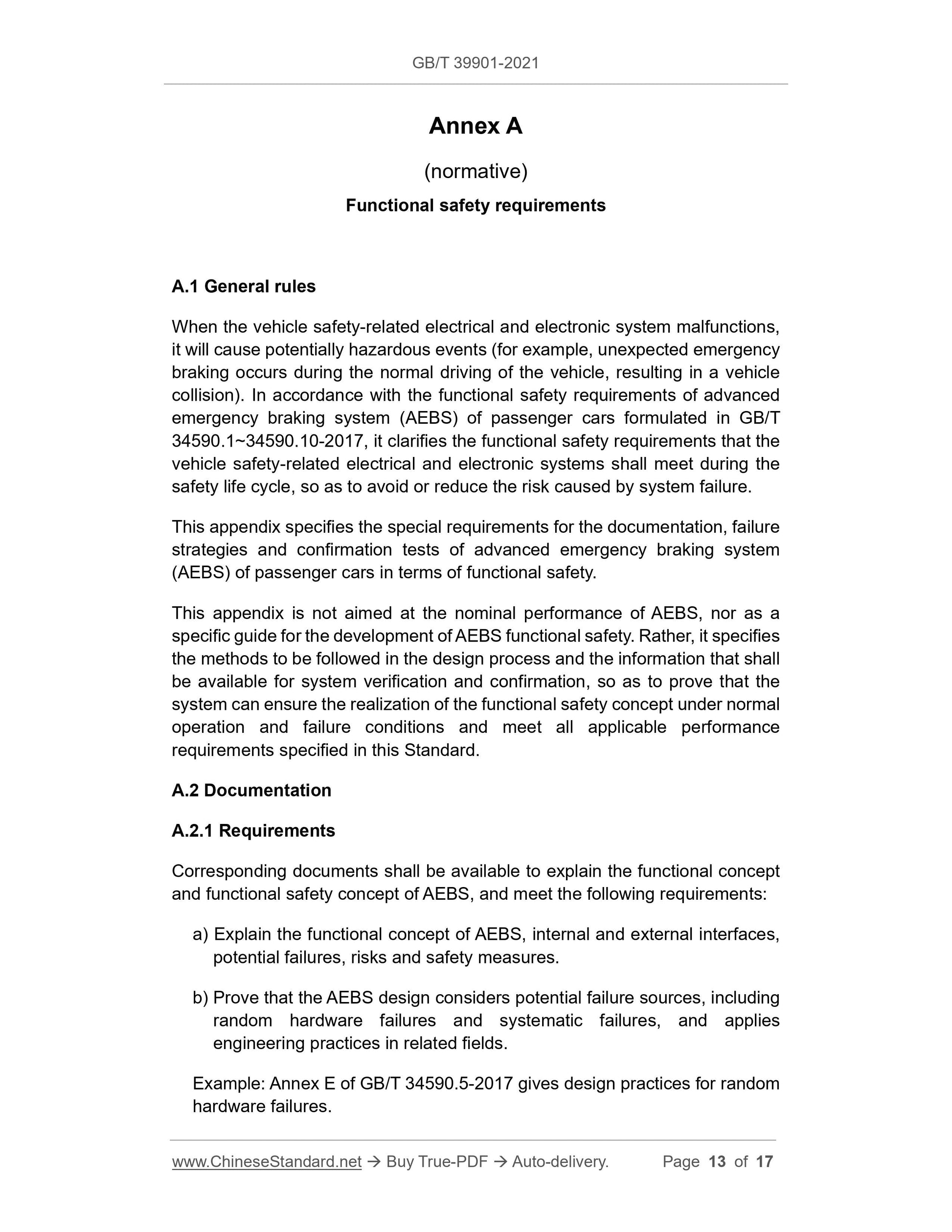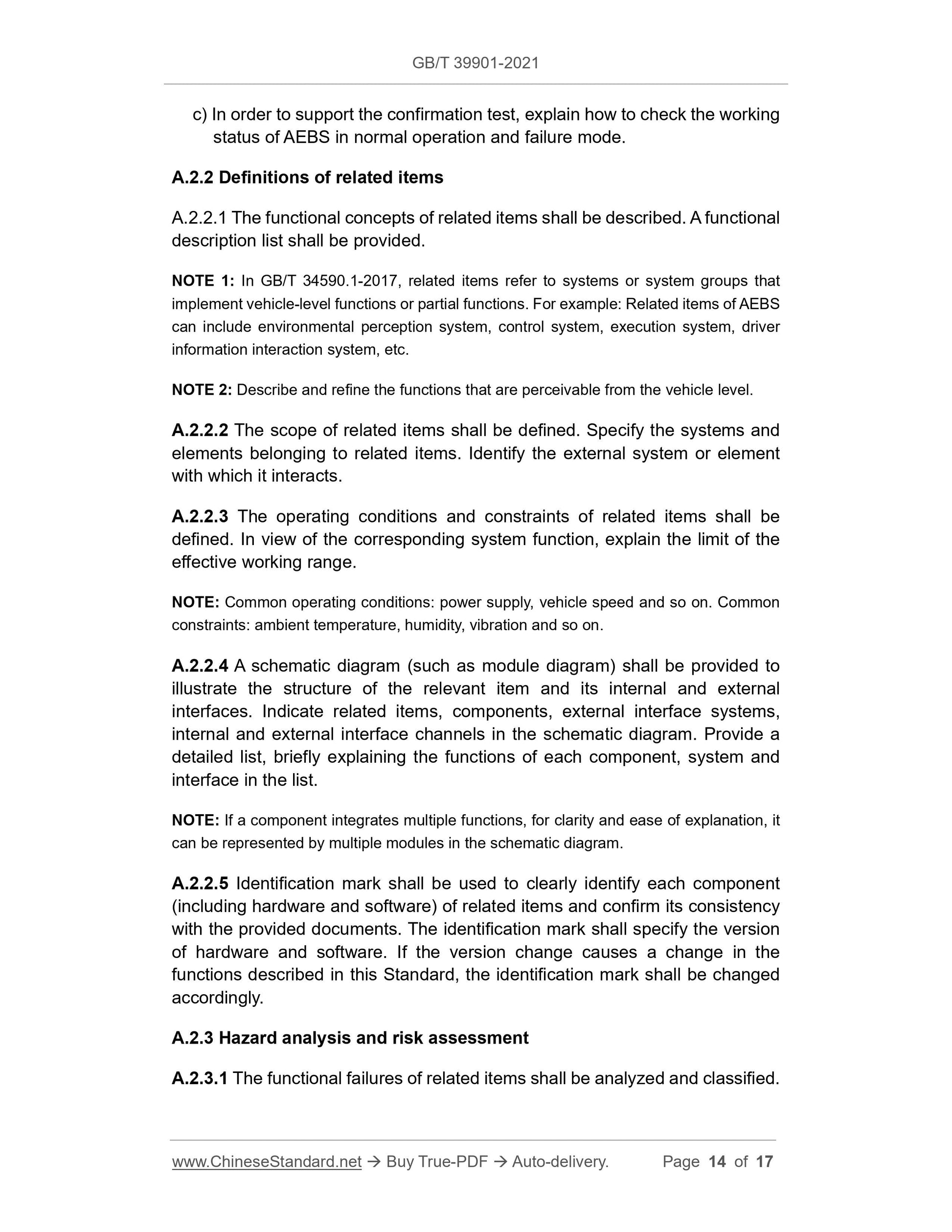PayPal, credit cards. Download editable-PDF and invoice in 1 second!
GB/T 39901-2021 English PDF (GBT39901-2021)
GB/T 39901-2021 English PDF (GBT39901-2021)
Precio habitual
$125.00 USD
Precio habitual
Precio de oferta
$125.00 USD
Precio unitario
/
por
Los gastos de envío se calculan en la pantalla de pago.
No se pudo cargar la disponibilidad de retiro
Delivery: 3 seconds. Download true-PDF + Invoice.
Get QUOTATION in 1-minute: Click GB/T 39901-2021
Historical versions: GB/T 39901-2021
Preview True-PDF (Reload/Scroll if blank)
GB/T 39901-2021: Performance requirements and test methods for advanced emergency braking system (AEBS) of passenger cars
GB/T 39901-2021
GB
NATIONAL STANDARD OF THE
PEOPLE’S REPUBLIC OF CHINA
ICS 43.040.40
T 24
Performance requirements and test methods for
advanced emergency braking system (AEBS) of
passenger cars
ISSUED ON: MARCH 9, 2021
IMPLEMENTED ON: OCTOBER 1, 2021
Issued by: State Administration for Market Regulation;
Standardization Administration of the People's Republic of
China.
Table of Contents
Foreword ... 3
1 Scope ... 4
2 Normative references ... 4
3 Terms and definitions ... 4
4 Technical requirements ... 6
5 Test methods ... 9
Annex A (normative) Functional safety requirements ... 13
Bibliography ... 17
Performance requirements and test methods for
advanced emergency braking system (AEBS) of
passenger cars
1 Scope
This Standard specifies terms and definitions, technical requirements and test
methods for advanced emergency braking system (AEBS) of passenger cars.
This Standard is applicable to category M1 cars equipped with advanced
emergency braking system (AEBS).
2 Normative references
The following referenced documents are indispensable for the application of
this document. For dated references, only the edition cited applies. For undated
references, the latest edition of the referenced document (including any
amendments) applies.
GB 4094-2016, Motor vehicles - Symbols for controls, indicators and tell-
tales
GB/T 5620, Road vehicles - Vocabulary and definition for braking of
automotive vehicles and their trailers
GB 21670-2008, Technical requirements and testing methods for passenger
car braking systems
GB/T 34590.1~34590.10-2017, Road vehicles - Functional safety
GB 34660, Road vehicles - Requirements and test methods of
electromagnetic compatibility
3 Terms and definitions
For the purposes of this document, the terms and definitions defined in GB/T
5620 as well as the followings apply.
3.1 advanced emergency braking system; AEBS
a system that monitors the driving environment in front of the vehicle in real
time, and automatically activates the vehicle braking system to slow the vehicle
when a collision risk may occur, so as to avoid collisions or reduce collisions
3.2 subject vehicle
a vehicle tested in accordance with the relevant requirements of AEBS of
passenger car
3.3 target
a mass-produced ordinary passenger car as defined in GB/T 3730.1 OR
representative object that the detection parameters can represent the above
vehicle and is suitable for AEBS sensing detection characteristics
3.4 stationary target
a target that keeps still in the center of the same lane in front of the subject
vehicle
3.5 moving target
a target that is moving in the same direction at a constant speed in the center
of the same lane in front of the subject vehicle
3.6 braking target
a target that is directly in front of the center of the driving route of the subject
vehicle, that originally drove at a constant speed in the same direction as the
subject vehicle and then started to decelerate
3.7 emergency braking phase
a phase that under the control of AEBS, the subject vehicle decelerates with a
deceleration of at least 4m/s2
3.8 common space
an area where two or more kinds of information (such as signs) can be
displayed asynchronously
[GB 4094-2016, definition 3.6]
3.9 time to collision; TTC
the distance between the subject vehicle and the target divided by the
instantaneous relative speed of the subject vehicle and the target
way.
4.2.5 The failure warning signal shall be a yellow warning signal that is always
bright. It can be expressed in text or graphics. This requirement does not apply
to warning signs displayed in the common space.
4.2.6 When the ignition (start) switch is in the "on" (running) state or the ignition
(start) switch is between "on" (running) and "start", when the manufacturer
specifies the position for inspection, every optical warning signal shall start to
light up. This requirement does not apply to warning signals displayed in the
common space.
4.2.7 The optical warning signal shall be clearly visible even during the day so
that it is convenient for the driver to check the signal status in the normal driving
position.
4.3 Performance requirements
4.3.1 Basic performance
AEBS shall meet the following requirements during normal operation:
a) With early warning and emergency braking functions.
b) Except for the conditions specified in 4.5, the system shall operate
normally between the vehicle speed of 15km/h and the maximum
operating speed of the AEBS system under all load conditions of the
vehicle.
c) If it encounters working conditions such as the sudden insertion of the
vehicle in front, the collision cannot be predicted in time, and the collision
warning signal cannot be issued 1s before the emergency braking, then
the collision warning signal shall be issued no later than the emergency
braking phase.
4.3.2 Early warning and starting performance under stationary target
conditions
4.3.2.1 Test according to 5.3. The subject vehicle shall use at least two modes
of acoustic, tactile and optical early warnings 1s before the start of the
emergency braking phase at the latest. The speed drop in the early warning
phase shall not exceed 15km/h or 30% of the speed of the subject vehicle.
Whichever is higher.
4.3.2.2 The subject vehicle shall not collide with the stationary target.
4.3.2.3 The emergency braking phase shall not start 3s before the estimated
collision time.
4.3.2.4 At least 3 of 5 tests shall meet the requirements of 4.3.2.1~4.3.2.3.
4.3.3 Early warning and start performance under moving target conditions
4.3.3.1 Test according to 5.4. The subject vehicle shall use at least two modes
of acoustic, tactile and optical early warnings 1s before the start of the
emergency braking phase at the latest. The speed drop in the early warning
phase shall not exceed 15km/h or 30% of the speed of the subject vehicle.
Whichever is higher.
4.3.3.2 The subject vehicle shall not collide with the moving target.
4.3.3.3 The emergency braking phase shall not start 3s before the estimated
collision time.
4.3.3.4 At least 3 of 5 tests shall meet the requirements of 4.3.3.1~4.3.3.3.
4.3.4 Early warning and start performance under braking target conditions
4.3.4.1 Test according to 5.5. The subject vehicle shall use at least two modes
of acoustic, tactile and optical early warnings 1s before the start of the
emergency braking phase at the latest. The speed drop in the early warning
phase shall not exceed 15km/h or 30% of the speed of the subject vehicle.
Whichever is higher.
4.3.4.2 The subject vehicle shall not collide with the braking target.
4.3.4.3 The emergency braking phase shall not start 3s before the estimated
collision time.
4.3.4.4 At least 3 of 5 tests shall meet the requirements of 4.3.4.1~4.3.4.3.
4.4 Warning signal after system failure
Test according to 5.6. The always-on optical warning signal that meets the
requirements of GB 4094-2016 shall be activated when the vehicle is driving at
a speed greater than 15km/h for 10s at the latest. As long as the failure still
exists and the vehicle is at a standstill after turning off the ignition switch and
then turning it on again, the failure warning signal shall be re-illuminated
immediately.
4.5 Driver intervention performance
4.5.1 AEBS allows the driver to interrupt the early warning phase.
4.5.2 A...
Get QUOTATION in 1-minute: Click GB/T 39901-2021
Historical versions: GB/T 39901-2021
Preview True-PDF (Reload/Scroll if blank)
GB/T 39901-2021: Performance requirements and test methods for advanced emergency braking system (AEBS) of passenger cars
GB/T 39901-2021
GB
NATIONAL STANDARD OF THE
PEOPLE’S REPUBLIC OF CHINA
ICS 43.040.40
T 24
Performance requirements and test methods for
advanced emergency braking system (AEBS) of
passenger cars
ISSUED ON: MARCH 9, 2021
IMPLEMENTED ON: OCTOBER 1, 2021
Issued by: State Administration for Market Regulation;
Standardization Administration of the People's Republic of
China.
Table of Contents
Foreword ... 3
1 Scope ... 4
2 Normative references ... 4
3 Terms and definitions ... 4
4 Technical requirements ... 6
5 Test methods ... 9
Annex A (normative) Functional safety requirements ... 13
Bibliography ... 17
Performance requirements and test methods for
advanced emergency braking system (AEBS) of
passenger cars
1 Scope
This Standard specifies terms and definitions, technical requirements and test
methods for advanced emergency braking system (AEBS) of passenger cars.
This Standard is applicable to category M1 cars equipped with advanced
emergency braking system (AEBS).
2 Normative references
The following referenced documents are indispensable for the application of
this document. For dated references, only the edition cited applies. For undated
references, the latest edition of the referenced document (including any
amendments) applies.
GB 4094-2016, Motor vehicles - Symbols for controls, indicators and tell-
tales
GB/T 5620, Road vehicles - Vocabulary and definition for braking of
automotive vehicles and their trailers
GB 21670-2008, Technical requirements and testing methods for passenger
car braking systems
GB/T 34590.1~34590.10-2017, Road vehicles - Functional safety
GB 34660, Road vehicles - Requirements and test methods of
electromagnetic compatibility
3 Terms and definitions
For the purposes of this document, the terms and definitions defined in GB/T
5620 as well as the followings apply.
3.1 advanced emergency braking system; AEBS
a system that monitors the driving environment in front of the vehicle in real
time, and automatically activates the vehicle braking system to slow the vehicle
when a collision risk may occur, so as to avoid collisions or reduce collisions
3.2 subject vehicle
a vehicle tested in accordance with the relevant requirements of AEBS of
passenger car
3.3 target
a mass-produced ordinary passenger car as defined in GB/T 3730.1 OR
representative object that the detection parameters can represent the above
vehicle and is suitable for AEBS sensing detection characteristics
3.4 stationary target
a target that keeps still in the center of the same lane in front of the subject
vehicle
3.5 moving target
a target that is moving in the same direction at a constant speed in the center
of the same lane in front of the subject vehicle
3.6 braking target
a target that is directly in front of the center of the driving route of the subject
vehicle, that originally drove at a constant speed in the same direction as the
subject vehicle and then started to decelerate
3.7 emergency braking phase
a phase that under the control of AEBS, the subject vehicle decelerates with a
deceleration of at least 4m/s2
3.8 common space
an area where two or more kinds of information (such as signs) can be
displayed asynchronously
[GB 4094-2016, definition 3.6]
3.9 time to collision; TTC
the distance between the subject vehicle and the target divided by the
instantaneous relative speed of the subject vehicle and the target
way.
4.2.5 The failure warning signal shall be a yellow warning signal that is always
bright. It can be expressed in text or graphics. This requirement does not apply
to warning signs displayed in the common space.
4.2.6 When the ignition (start) switch is in the "on" (running) state or the ignition
(start) switch is between "on" (running) and "start", when the manufacturer
specifies the position for inspection, every optical warning signal shall start to
light up. This requirement does not apply to warning signals displayed in the
common space.
4.2.7 The optical warning signal shall be clearly visible even during the day so
that it is convenient for the driver to check the signal status in the normal driving
position.
4.3 Performance requirements
4.3.1 Basic performance
AEBS shall meet the following requirements during normal operation:
a) With early warning and emergency braking functions.
b) Except for the conditions specified in 4.5, the system shall operate
normally between the vehicle speed of 15km/h and the maximum
operating speed of the AEBS system under all load conditions of the
vehicle.
c) If it encounters working conditions such as the sudden insertion of the
vehicle in front, the collision cannot be predicted in time, and the collision
warning signal cannot be issued 1s before the emergency braking, then
the collision warning signal shall be issued no later than the emergency
braking phase.
4.3.2 Early warning and starting performance under stationary target
conditions
4.3.2.1 Test according to 5.3. The subject vehicle shall use at least two modes
of acoustic, tactile and optical early warnings 1s before the start of the
emergency braking phase at the latest. The speed drop in the early warning
phase shall not exceed 15km/h or 30% of the speed of the subject vehicle.
Whichever is higher.
4.3.2.2 The subject vehicle shall not collide with the stationary target.
4.3.2.3 The emergency braking phase shall not start 3s before the estimated
collision time.
4.3.2.4 At least 3 of 5 tests shall meet the requirements of 4.3.2.1~4.3.2.3.
4.3.3 Early warning and start performance under moving target conditions
4.3.3.1 Test according to 5.4. The subject vehicle shall use at least two modes
of acoustic, tactile and optical early warnings 1s before the start of the
emergency braking phase at the latest. The speed drop in the early warning
phase shall not exceed 15km/h or 30% of the speed of the subject vehicle.
Whichever is higher.
4.3.3.2 The subject vehicle shall not collide with the moving target.
4.3.3.3 The emergency braking phase shall not start 3s before the estimated
collision time.
4.3.3.4 At least 3 of 5 tests shall meet the requirements of 4.3.3.1~4.3.3.3.
4.3.4 Early warning and start performance under braking target conditions
4.3.4.1 Test according to 5.5. The subject vehicle shall use at least two modes
of acoustic, tactile and optical early warnings 1s before the start of the
emergency braking phase at the latest. The speed drop in the early warning
phase shall not exceed 15km/h or 30% of the speed of the subject vehicle.
Whichever is higher.
4.3.4.2 The subject vehicle shall not collide with the braking target.
4.3.4.3 The emergency braking phase shall not start 3s before the estimated
collision time.
4.3.4.4 At least 3 of 5 tests shall meet the requirements of 4.3.4.1~4.3.4.3.
4.4 Warning signal after system failure
Test according to 5.6. The always-on optical warning signal that meets the
requirements of GB 4094-2016 shall be activated when the vehicle is driving at
a speed greater than 15km/h for 10s at the latest. As long as the failure still
exists and the vehicle is at a standstill after turning off the ignition switch and
then turning it on again, the failure warning signal shall be re-illuminated
immediately.
4.5 Driver intervention performance
4.5.1 AEBS allows the driver to interrupt the early warning phase.
4.5.2 A...
Share











